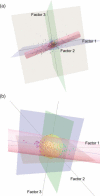A new method for gene discovery in large-scale microarray data
- PMID: 16537840
- PMCID: PMC1401514
- DOI: 10.1093/nar/gkl058
A new method for gene discovery in large-scale microarray data
Abstract
Microarrays are an effective tool for monitoring genome-wide gene expression levels. In current microarray analyses, the majority of genes on arrays are frequently eliminated for further analysis because the changes in their expression levels (ratios) are considered to be not significant. This strategy risks failure to discover whole sets of genes related to a quantitative trait of interest, which is generally controlled by several loci that make various contributions. Here, we describe a high-throughput gene discovery method based on correspondence analysis with a new index for expression ratios [arctan (1/ratio)] and three artificial marker genes. This method allows us to quickly analyze the whole microarray dataset and discover up-/down-regulated genes related to a trait of interest. We employed an example dataset to show the theoretical advantage of this method. We then used the method to identify 88 cancer-related genes from a published microarray data from patients with breast cancer. This method also allows us to predict the phenotype of a given sample from the gene expression profile. This method can be easily performed and the result is also visible in 3D viewing software that we have developed.
Figures



References
-
- Hughes T.R., Mao M., Jones A.R., Burchard J., Marton M.J., Shannon K.W., Lefkowitz S.M., Ziman M., Schelter J.M., Meyer M.R., et al. Expression profiling using microarrays fabricated by an ink-jet oligonucleotide synthesizer. Nat. Biotechnol. 2001;19:342–347. - PubMed
Publication types
MeSH terms
Substances
LinkOut - more resources
Full Text Sources
Other Literature Sources

